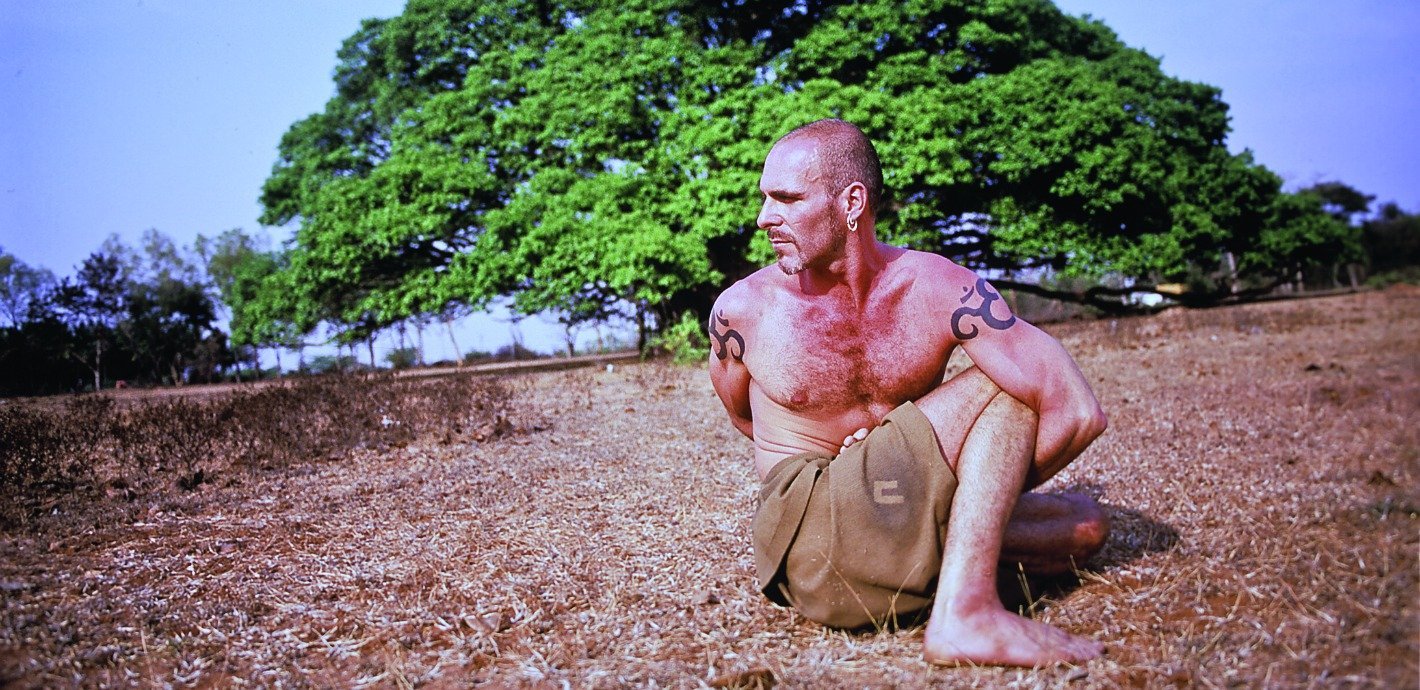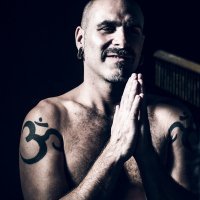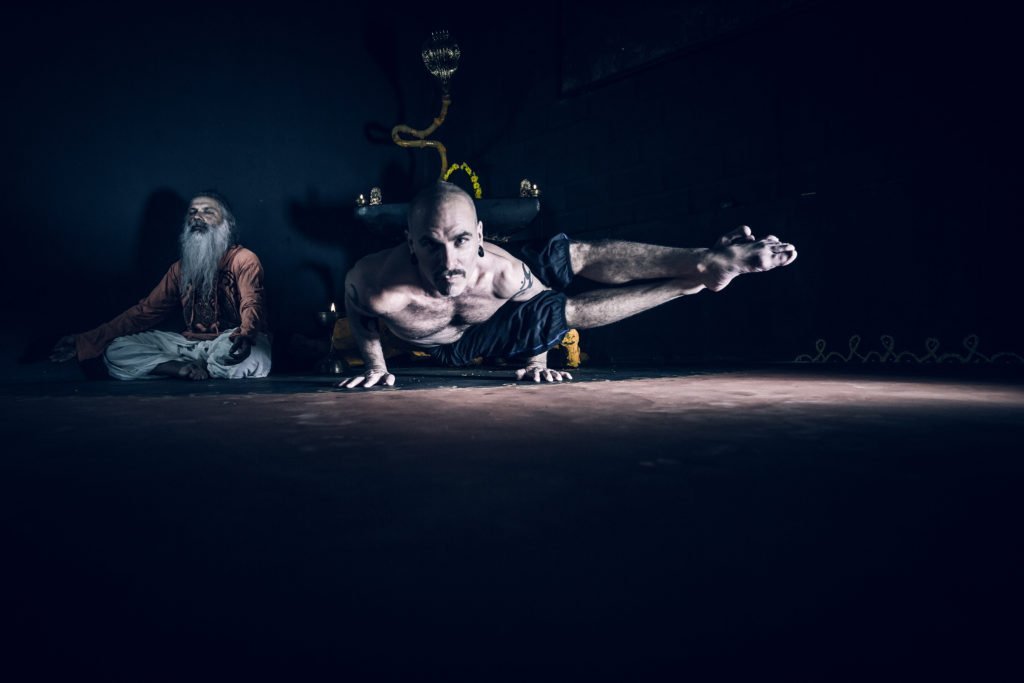My wife, Larissa, and I have been practicing Ashtanga yoga with Sharath Jois almost yearly since 2005. We most recently met our guru at his six-day yoga workshop in California as part of his three-city U.S. tour in May. For us, he shines his light to see the truth. His awareness reveals so much about us, from how we’ve been practicing and managing ourselves to how we’ve been thinking. His presence is like a flash of lightning, instantly improving my clarity and sharpening my humility. He knows me and sees me exactly as I am. There is no hiding from him. My delusions dissolve in his glow, and that is just the kind of teacher I need to keep going on this path.
Sharath is a powerful beacon of light for the brave, bold, and curious to seek out. As a lighthouse in the darkness, he guided this battered being to the rocky, yet wonderful shores of Ashtanga yoga. How did Sharath do this? The simple answer: His amazing ability to perform asana, knowledge of scripture, expert adjustments, and inspiring lectures are the reasons thousands apply to practice and follow with him wherever he goes, from south central India to his world tours.
A more complex and deeply personal answer: Experience—not talent, ability or charisma—is what brings me back to him every chance that I get. Sharath found this yoga method in the light of his legendary grandfather Shri K. Pattabhi Jois. Growing up in Guruji’s house, he was literally raised with yoga right from the start. I have met all the Ashtanga celebrities, and I can say, without a doubt, no one has been steeped in it like Sharath. He did not inherit his role. He earned it through hard work, sacrifice, and pain like no other. That is why I follow him. He has the most practical experience. Plus, he is an honest and good man—something I have not always been.
Unlike Sharath, I was not a “good” boy. By age 11, I had decided that my parents, religion, school, and society as a whole were all as fake as Santa Claus. I held a deep distrust for western medicine, all religions, consumer technology, mainstream media, and the world of capitalist mobility. I disdained politics most of all. Morality itself got turned upside down for me. I lost all faith in the country club “heaven” I saw my parents and their friends aspiring to. Everyone seemed to be in a race to “figure it out” as soon as possible. Like any game, once the rules are understood, it was work to win for most people. I witnessed firsthand humanity’s intolerance for anyone who didn’t play by these rules. I decided to fall madly in love with strangeness and quirk, and resolved to abandon the “game” entirely.
Like a bad 80’s movie, I grew out my hair, pierced my ears, and embraced the clichéd lifestyle of heavy metal, getting high, and drinking. My parents and their friends thought I was going to hell and I figured, why not. At least in hell, they probably played the kind of music I liked, I thought. It took a little while for me to see that being labeled “bad” was almost as fake as pretending I was “good” for others’ sake.
In the following years, I tried a wide variety of styles and fads. I studied and devoured art, film, and music across the spectrum. It was through art that I discovered the relativity of beauty and truth, and it was art that liberated me from the traps of “ping pong” dualistic thinking. In creating and studying art, I was reborn without boundary, duty or group affiliation. My parents and teachers couldn’t control or influence me at all and it wasn’t long before they gave up trying. It was a “choose your own adventure” at that point and I didn’t always choose wisely.
My love for cannabis and wild people often surrounded me with gang members, dealers, and morally ambiguous seekers, like myself. Not the brightest think-tank of superstars to roll with, but it was exciting. Shortly after, I was sneaking out of the house to see girlfriends, brawling and getting arrested. Running from the police and sitting in the back of cop cars was a regular thing for me, and by the tender age of 22, I had earned myself a felony conspiracy to deliver narcotics charge.
I was dealing large amounts of cannabis, making money, and getting bolder. It blows my mind that 20 years later cannabis is a colossal legal industry in much of the U.S. and Europe. Things have certainly changed, but back in November of 1996, it was a serious crime. I got set up by some “friends” who had become informants for the police. I never imagined that the law would come down on me as hard as it did.
While most of my generation was starting their adult life, I was experiencing the merciless death of mine. Hearing one’s criminal sentencing is like attending your own funeral. You get to see who cares and who doesn’t among friends and family. Despite the fact that hundreds of my friends and family and even the local news came out to support me, mandatory minimum guidelines demanded that I receive the minimum of 10 years in the state penitentiary.
With the sound of a gavel slamming down, freedom became a memory. Back then, U.S. prisons were gladiator universities, schools for sociopaths, criminal colleges and a billion-dollar industry that profits from despair. The department of corrections in America is a catastrophic shame. In my experienced opinion, the prison system is a blight of dysfunctional embarrassment, displaying to the world this proud nation’s willful ignorance. That is something I want to help change, yet it was in the darkness of this destruction and isolation that I found the light of yoga.
Related: The Healing Potential of Yoga Training in Prison
I had learned a few dozen yoga postures from my jujutsu sensei prior to my incarceration. I only did it out of obligation—it was required to prepare my body for the physical rigors of martial arts training. My focus with asana was on its ability to enhance my martial skills in order to kick ass and destroy my opponents. I had no interest in any spiritual or philosophical aspects of yoga at that time.
To my disappointment, the maximum-security prison that was my home did not allow any type of martial arts exercise, not even the harmless practice of Tai Chi. If you broke this rule, an inmate could be sent to solitary confinement. The risk was too grave, so in order to keep myself sane, I began to do my 36-asana-yoga routine daily without exception.
In the isolation of my cell, I found that the asana practice had unique power that I had never felt before. The power to calm my nerves and soothe my emotions like nothing else could. I began to feel lighter and stronger mentally. I actually thrived in prison as a result. I resolved to read a book a day and mold myself into a more capable and intelligent person. I modeled myself after Edmond Dontes, the main character from the story The Count of Monte Cristo by Alexandre Dumas.
I was determined to make the “time” work for me. After six months, my appeal came up and I went back to the judge. With a small sentence reduction, I became eligible for a government program called Challenge Incarceration Program (CIP), an early release program for first-time, non-violent felons under the age of 30 who fit the prescribed criteria. CIP was run by joint military personnel from all four branches of the U.S. military.
CIP was a journey that I can only describe as torturous hell. Thankfully, after six months of it, I was free. Back on the street within a year and a better man for it, I returned to my dojo to finish my black belt, and school to complete my bachelor of fine arts, graduating with honors. I had a variety of jobs while in school and a lot of scrutiny from my parole officer. There is a lot of exploitation from employers when they know you have a felony record. Wages withheld and threats of revocation without provocation are commonplace. Balancing school, work, relationships, and the dojo, plus art projects with deadlines, was only possible because of my devotion to yoga practice. I did my practice every day for emotional and mental reasons. It kept me stable and steady as well as flexible and tough when life threw me into the dirt.
After three years of practicing, I started teaching in 1999, and then in 2001, I opened my own wellness center and yoga school in Waukesha, WI. My search for experienced teachers to join my studio led me to Boulder, CO, where I found Mysore-style Ashtanga under Richard Freeman. It was he who directed me to go to Mysore to properly learn the sequences and method from the Jois family.
Three months later, I was in Gokulam standing in front of Shri K. Pattabhi Jois. Luckily, my time in boot camp had prepared me for the discipline and many other challenges that I faced my first few trips—though barely. I know the Jois family thought I was crazy and they weren’t wrong. Sharath especially saw how much anger and frustration I had inside, and I knew I was a very challenging student for him. However, he didn’t give up on me.
Over the course of five years and five trips, I earned his trust and that was the impetus to start believing in myself, perhaps for the first time in my life. That dedication to the lineage and method now powers the only two authorized Ashtanga schools in Waukesha and Milwaukee, where Larissa and I run the daily Mysore programs.
Our success here—we currently have 80 or so students enrolled—in the Midwest is a testament to keeping the practice pure and teaching as if Guruji and Sharath are looking over our shoulders. We don’t advertise, sell products, or run any teacher training programs of any kind. Never have. Never will. We run morning Mysore programs and teach one led class per week.
My love for Ashtanga and learning has taken me around the globe and introduced me to hundreds of the world’s top teachers and healers. Ashtanga was the bond that connected me to my wife and all that we have now are fruits of our practice. But the greatest gift that Ashtanga has given is discernment. I still don’t believe in simple “good and bad,” but rather in the inherent complexity of human beings and the tricky situations that we face individually and collectively. Now, I use the yama, niyama, asana and pranayama as a moral compass to navigate through the spectrum of collective reality as well as my own inner inquiry. I ask myself when faced with choices: Will it harm? Whom could this possibly affect? What are the ripple effects of my decision? I apply this line of questioning to everything from my relationships to my purchases.
For me, this is the function of Ashtanga yoga—to create stability and steady, dependable willpower. With these, I can become a better person day-by-day. Ashtanga has shown me the power and responsibility that comes with choice and the importance of awareness, the long view, intuition and foresight. The yama is my unbreakable shield of honor and the niyama is my keen sword of discernment. The asana practice is my sharpening stone. It is tough and dependable. I use the pranayama to fortify my energy and keep my nervous system calm in the face of adversity. Despite the difficulty, I really do enjoy the asana and pranayama. Pain is there, but so is pleasure and I appreciate spectrum now more than ever. I consider injury and progress both to be very valuable as I ebb and flow through time.
If Ashtanga can heal my battered heart and lead me to the light, it can heal anyone. I’m still here. Twenty years after I was incarcerated, I’m still free. I credit yoga for that. My life is quite stable and full of wonder. I feel truly blessed. Whether you discover the yoga in the light or the darkness, or somewhere in between, it matters not. Only that we practice honestly. My dream is that with our newly acquired bioelectrical illumination (the glow we get from yoga) we all become lighthouse sanctuaries of awareness for any lost wanderer to find their way back from the illusion of separation. Let no one be left behind. I pray in gratitude for my magical teacher Shri Sharath Jois for his devoted light that informs my direction on this path of yoga. In solidarity with all living beings, may each and every one of us find peace.









Comments (0)